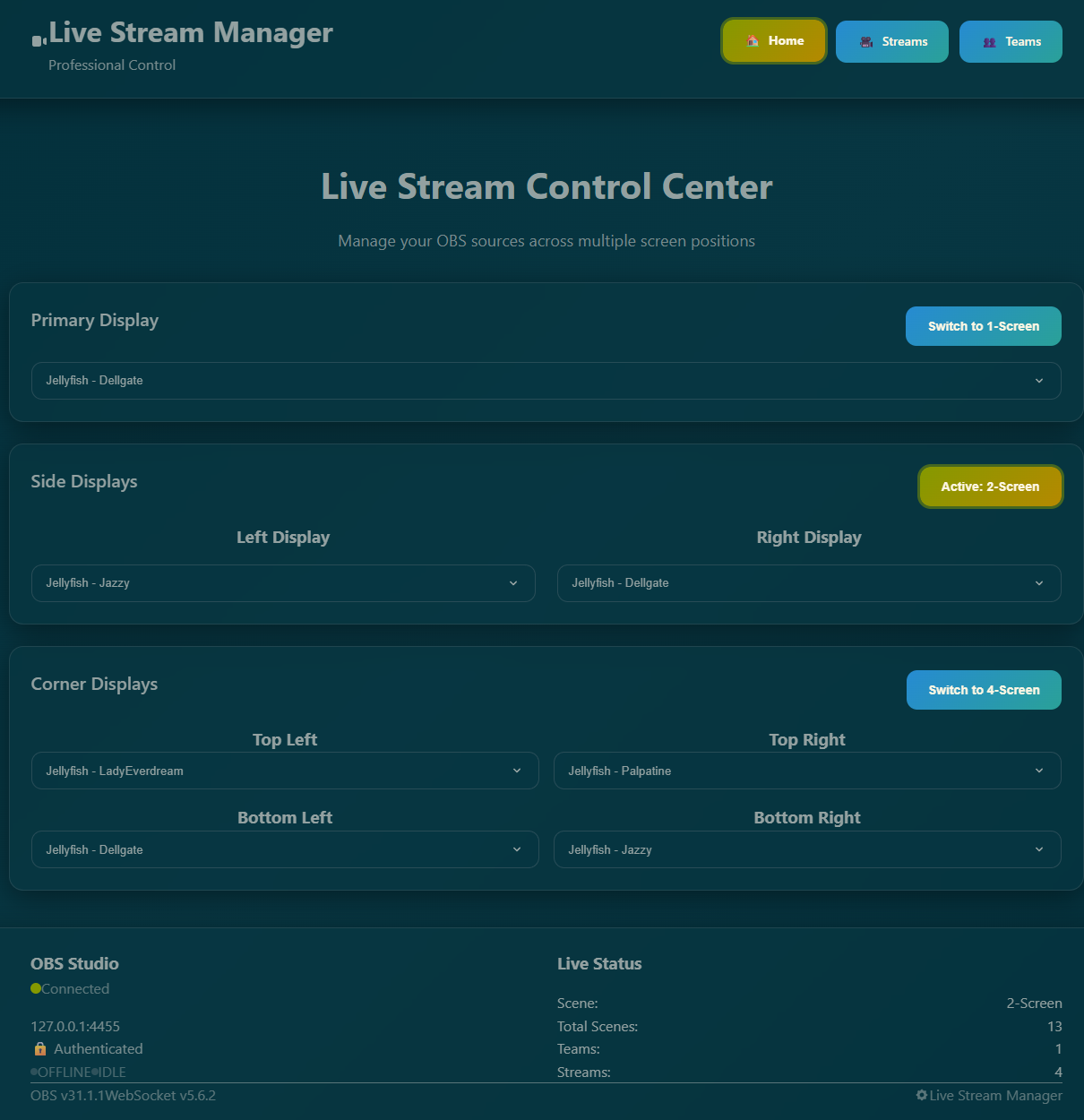- Add new screenshot (docs/new_home.png) showing scene switching buttons - Update README.md with new screenshot and scene control features - Update CLAUDE.md with comprehensive scene switching documentation - Update SaT.json with latest OBS configuration 🤖 Generated with [Claude Code](https://claude.ai/code) Co-Authored-By: Claude <noreply@anthropic.com>
6.6 KiB
Live Stream Manager
A professional Next.js web application for managing live streams and controlling multiple OBS Source Switchers with real-time WebSocket integration and modern glass morphism UI.
Features
- OBS Scene Control: Switch between OBS layouts (1-Screen, 2-Screen, 4-Screen) with dynamic button states
- Multi-Screen Source Control: Manage 7 different screen positions (large, left, right, and 4 corners)
- Real-time OBS Integration: WebSocket connection with live status monitoring
- Enhanced Stream Management: Create, edit, and delete streams with comprehensive OBS cleanup
- Team Organization: Organize streams by teams with full CRUD operations and scene synchronization
- Comprehensive Deletion: Remove streams/teams with complete OBS component cleanup (scenes, sources, text files)
- Audio Control: Browser sources created with muted audio and OBS control enabled
- Modern UI: Glass morphism design with responsive layout and accessibility features
- Professional Broadcasting: Audio routing, scene management, and live status indicators
- Dual Integration: WebSocket API + text file monitoring for maximum compatibility
- UUID-based Tracking: Robust OBS group synchronization with rename-safe tracking
- Enhanced Footer: Real-time team/stream counts and OBS connection status
- Optimized Performance: Reduced code duplication and standardized API responses
Quick Start
npm install
npm run dev
Open http://localhost:3000 to access the control interface.
Configuration
Environment Variables
Create .env.local in the project root:
# File storage directory (optional, defaults to ./files)
FILE_DIRECTORY=C:\\OBS\\source-switching
# OBS WebSocket settings (optional, these are defaults)
OBS_WEBSOCKET_HOST=127.0.0.1
OBS_WEBSOCKET_PORT=4455
OBS_WEBSOCKET_PASSWORD=your_password_here
# Security (IMPORTANT: Set in production)
API_KEY=your_secure_api_key_here
Security Setup
⚠️ IMPORTANT: Set API_KEY in production to protect your OBS setup from unauthorized access.
Generate a secure API key:
# Generate a random 32-character key
openssl rand -hex 32
Without an API key, anyone on your network can control your OBS streams.
OBS Source Switcher Setup
- In OBS, configure Source Switcher properties
- Enable "Current Source File" at the bottom
- Point to one of the generated text files (e.g.,
large.txt,left.txt) - Set read interval to 1000ms
- Sources will switch automatically when files change
Database Setup
The project includes an empty template database for easy setup:
# Option 1: Use template database directly (development)
# Database will be created in ./files/sources.db
npm run create-sat-summer-2025-tables
# Option 2: Set up custom database location (recommended)
# 1. Copy the template database
cp files/sources.template.db /path/to/your/database/sources.db
# 2. Set environment variable in .env.local
echo "FILE_DIRECTORY=/path/to/your/database" >> .env.local
# 3. Create tables in your custom database
npm run create-sat-summer-2025-tables
Template Database: The repository includes files/sources.template.db with the proper schema but no data. Your local development database (sources.db) is automatically ignored by git to prevent committing personal data.
Development Commands
npm run dev # Start development server
npm run build # Build for production
npm run start # Start production server
npm run lint # Run ESLint
npm run type-check # TypeScript validation
Architecture
- Frontend: Next.js 15 with React 19 and TypeScript
- Backend: Next.js API routes with SQLite database
- OBS Integration: WebSocket connection + text file monitoring
- Styling: Custom CSS with glass morphism and Tailwind utilities
- CI/CD: Forgejo workflows with self-hosted runners
API Endpoints
Stream Management
GET /api/streams- List all streams with team informationGET /api/streams/[id]- Get individual stream detailsPOST /api/addStream- Create new stream with browser source and team associationPUT /api/streams/[id]- Update stream informationDELETE /api/streams/[id]- Delete stream with comprehensive OBS cleanup:- Removes stream's nested scene
- Deletes browser source
- Removes from all source switchers
- Clears text files referencing the stream
Source Control
POST /api/setActive- Set active stream for screen position (writes team-prefixed name to text file)GET /api/getActive- Get currently active sources for all screen positions
Team Management
GET /api/teams- Get all teams with group information and sync statusPOST /api/teams- Create new team with optional OBS scene creationPUT /api/teams/[teamId]- Update team name, group_name, or group_uuidDELETE /api/teams/[teamId]- Delete team with comprehensive OBS cleanup:- Deletes team scene/group
- Removes team text source
- Deletes all associated stream scenes
- Removes all browser sources with team prefix
- Clears all related text files
GET /api/getTeamName- Get team name by ID
OBS Group/Scene Management
POST /api/createGroup- Create OBS scene from team and store UUIDPOST /api/syncGroups- Synchronize all teams with OBS groupsGET /api/verifyGroups- Verify database groups exist in OBS with UUID tracking- Detects orphaned groups (excludes system scenes)
- Identifies name mismatches
- Shows sync status for all teams
OBS Scene Control
POST /api/setScene- Switch OBS to specified scene (1-Screen, 2-Screen, 4-Screen)GET /api/getCurrentScene- Get currently active OBS scene
System Status
GET /api/obsStatus- Real-time OBS connection, streaming, and recording status
Authentication
All endpoints require API key authentication when API_KEY environment variable is set.
See CLAUDE.md for detailed architecture documentation and implementation details.
Known Issues
Text Centering
- Issue: Team name text overlays position left edge at center instead of centering the text itself
- Workaround: Manually change "Positional Alignment" to "Center" in OBS UI
- Status: Under investigation - requires further research into OBS API behavior
System Scene Exclusion
Infrastructure scenes containing source switchers are excluded from orphaned group detection:
- 1-Screen, 2-Screen, 4-Screen, Starting, Ending, Audio, Movies
- Additional scenes can be added to the
SYSTEM_SCENESarray in/app/api/verifyGroups/route.ts
